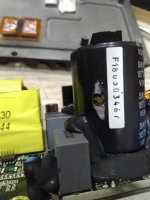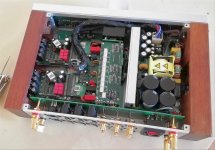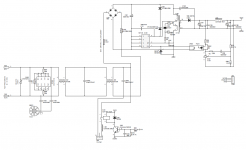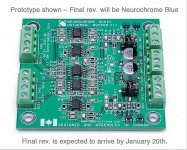Nope. For example, many IcePower 1200AS2 users have stated many times that they appreciate quite a difference when changing the power cables (audiophiles, built so that they act as low pass filters but with very low slope -> very low RF/EMI attenuation) -> It is indicative that the PSRR must be low, < or << 90 dB.
Review and Measurements of Purifi 1ET400A Amplifier | Page 24 | Audio Science Review (ASR) Forum
Other story is that instead of trying to solve their problems by spending a lot of money on cables they have not thought about spending much less by resorting to proven professional solutions and of which we have attenuation graphs.
Review and Measurements of Purifi 1ET400A Amplifier | Page 24 | Audio Science Review (ASR) Forum
With Hypex NC too, but in less number -> maybe the Hypex SMPS1200 is cleaner than the Icepower SMPS and isolates more from the noise and interferences from the mains.PURIFI 1ET400A -> PSRR > 90 dB
- NC500 -> PSRR of 85 dB
- NC400 -> PSRR of 80 dB
- NC1200 -> PSRR of 80 dB how expensive and it is 5 dB less!
- NC2K -> PSRR of 70 dB
- NC250MP -> PSRR ?
- NC500MP -> PSRR ?
Other story is that instead of trying to solve their problems by spending a lot of money on cables they have not thought about spending much less by resorting to proven professional solutions and of which we have attenuation graphs.
Last edited:
Aren't ClassD amps less susceptible to power supply quality?
Never heard this.
I remember a comparison between a hypex smps and a linear ps with large $$ capacitor bank didn't bring the expected outcome.
This however does not surprise me. A good SMPS is not inferior to a linear PS.
Review and Measurements of Purifi 1ET400A Amplifier | Page 56 | Audio Science Review (ASR) Forum
Picture resized, optimized and clarified.By Dudi
Purifi eval board is retrofitted to my previous amplifier, so it has volume control, remote and input selector with RCA-XLR converter. It sounds amazing, but slightly worse than the pure eval board.
1ET400A generates close to zero heat but SMPS1200 gets warm.
(top cover is drilled at SMPS)
Attachments
Last edited:
Roberto, I only TRUST in very few persons when they comment on the sound quality of the amplifiers. ALL recognized diyers that have built many amplifiers and loudspeakers.
If it were not for that, I would not have spent that money on those capacitors or, recently, on others to bypass the tweeter capacitor and change the cemented resistance. Step by step to verify the changes, with the same person by my side.
If I was not so cautious, I would not wait a few months before the possible purchase of the kit. I followed the development of the ODAC (NwAvGuy) from the beginning and it still took months to order the purchase. To experience and / or presume others first is my rule.
Everybody has biases. Also DIYers. In fact, they usually perceive that the more work of their own they put in their builds, or even the more they "just" research among off-the-shelf stuff, the better their builds sound. They are human beings. They also may not have the possibility to use different SMPSs and do a proper ABX test of two otherwise identical amplifiers, differing in just the SMPS. This is very, very difficult.
To me, if somebody says that a SMPS sounds "dry" it does not mean anything, because dry means nothing as a sound description (and the only meanings I can find are actually positive - less "bloomy", i.e. less temporal and harmonic distorsion). So, even if cresnet just reported it, I claim that whomever told him so said nonsense (and again, I have no criticistm towards an engineer that is doing a great service).
Roberto
Other story is that instead of trying to solve their problems by spending a lot of money on cables they have not thought about spending much less by resorting to proven professional solutions and of which we have attenuation graphs.
Yeah they probably missed the professional solutions. They should come here more and read the advice from people like themselves. So much they can learn! 😎
Jan
Roberto, with linear PSU it is true: it changes the sound, if the mains are dirty. With SMPS? I can not say anything. At least I would obviate my BIG problem with DC at mains.
Very good question indeed, and here are some points:-
1- Using higher quality components, only highest quality .
2- All SMPS units I make can be repaired by the user.
3- Unmatched technical support.
4-My SMPS units offers things HYPEX dont offer, like STANDBY switch replacing mechanical switches, AC LOSS output, Isolated AUX12V output.
5- Usually they sound better than HYPEX, and this was proven by the DIY community not by me.
6- Cheaper than HYPEX
HYPEX
1- Using lower quality components
2- If HYPEX SMPS failes, 95% chance is send it to trash, and this is also for most products made by them, I have received countless number of powered speakers uses there modules and SMPS, and they all went to trash. replace full module.
3- Ask them for support, they ask you to send the product back.
4- they dont offer those things
5- they sound dry
6- it is expensive
I have no intention in any way to degrade the HYPEX products quality, they are great company who delivers very nice products, and in no way I can compete with them sooner or later. This is a market for business and HYPEX is pretty large company with talented people.
Thats only an answer to your question, and I am making SMPS units for the DIY community.
Looking at the Hypex SMPS I noticed that they they using an independent 3.3V isolated logic line to shutdown the the main power supply and for stand-by logic, this is a good technique to command shutdown logic during hard fault conditions (independent from the main supply line) .. I would be interested if your power supplies does this. vie attached an example.
Attachments
@Reactance
My SMPS has the same thing, except two things
1- The voltage is 12VD not 3.3V, you can regulate that easily to any voltage.
2- I am not using a relay to power ON / power OFF the SMPS
Also, the AUX SMPS is online as long as it is connected to the mains, and that wont affect the main SMPS ON / OFF function.
Also, DC-ERROR, AC-LOSS, FAN
I am not sure if that schematic is from HYPEX even.
Good luck my friend
My SMPS has the same thing, except two things
1- The voltage is 12VD not 3.3V, you can regulate that easily to any voltage.
2- I am not using a relay to power ON / power OFF the SMPS
Also, the AUX SMPS is online as long as it is connected to the mains, and that wont affect the main SMPS ON / OFF function.
Also, DC-ERROR, AC-LOSS, FAN
I am not sure if that schematic is from HYPEX even.
Good luck my friend
Last edited:
@Reactance
My SMPS has the same thing, except two things
1- The voltage is 12VD not 3.3V, you can regulate that easily to any voltage.
2- I am not using a relay to power ON / power OFF the SMPS
Also, the AUX SMPS is online as long as it is connected to the mains, and that wont affect the main SMPS ON / OFF function.
Also, DC-ERROR, AC-LOSS, FAN
I am not sure if that schematic is from HYPEX even.
Good luck my friend
That is a variant of their SMPS for the NAD M22 schematic. you can find it on the internet.
Perhaps all this is a moot point. From the Purifi web site:
High power supply rejection ratio (PSRR)
The module places no particular demands on the power supply quality. A simple off-the-shelf unregulated SMPS will not degrade audio performance.
High power supply rejection ratio (PSRR)
The module places no particular demands on the power supply quality. A simple off-the-shelf unregulated SMPS will not degrade audio performance.
The modules, with PSRR > 90 dB no problema.
But how clean is the auxiliary output from Hypex SMPS1200 or others to power the buffers? And, specially, the kit buffer.
But how clean is the auxiliary output from Hypex SMPS1200 or others to power the buffers? And, specially, the kit buffer.
Talking about buffers, just now in my e-mail:
Universal Buffer – Neurochrome
Universal Buffer – Neurochrome
The Universal Buffer is a two-channel (stereo) buffer, which can be configured to provide any of the following functions:
The Universal Buffer offers dramatic improvements in performance over the THAT Driver, THAT Receiver, and Differential Preamp 8x2, which it replaces. Some of the specification highlights include:
- Single-ended (unbalanced, RCA) to differential (balanced, XLR) conversion.
- Differential (balanced, XLR) to single-ended (unbalanced, RCA) conversion.
- Straight-through buffer (single-ended to single-ended or differential to differential).
- Signal inverter.
- Can be configured with gain by adding two resistors.
-140 dBc (0.00001%) THD
< -148 dB multi-tone IMD residual
137 dB dynamic range
> 125 dB channel separation (20 Hz - 20 kHz)
1.7 µV RMS residual mains hum & noise (20 Hz - 20 kHz, A-weighted)
The Universal Buffer requires a regulated power supply in the range of ±2.5 V to ±17 V to operate and draws 65 mA per stereo board.
Attachments
Last edited:
Purifi PTT6.5 Woofer and 1ET400A Amplifier Technology Review - Reviews - Audiophile Style
I thought I would ask Purifi’s Lars Risbo, one of the brains behind the PTT6.5 woofer, to describe their design approach on how they were able to obtain such low measured intermodulation distortion numbers:
“Our PTT6.5 woofer is the result of about 4 years of research. It has been a fruitful teamwork between Bruno, Carsten, Morten, and myself. This has resulted in a design that is vastly different from conventional drivers. In short, we have been on a crusade against all sources of intermodulation distortion. Psychoacoustics has correctly shown that our ears are not that sensitive to pure harmonic distortion – especially in the bass. However, our ears are way less forgiving when it comes to IMD when listening to complex music program material. Since it is impossible to only generate harmonic distortion without IMD, it has been necessary to reduce all nonlinear mechanisms in a speaker.
The most known source of IMD is the position dependent force factor Bl(x) which we have made ruler flat over +-6mm excursion (+-10mm at -10% Bl). Less known is the current and frequency dependent modulation of the force factor (aka force factor modulation, flux modulation, reluctance force) which we have reduced by up to 40dB over comparable standard motors. Then we have the position dependent inductance which causes a modulation of the drive current, again reduced by a huge factor. A new (re)discovery is the gain modulation caused by the varying radiating area of conventional surrounds – this can cause an amplitude modulation of the midrange by +-10% easily. This has been reduced by orders of magnitude by our very special surround geometry.
Finally, an extremely annoying distortion mechanism is the hysteretic memory of the iron in the motor. This distortion leads to a grainy non dynamic sound and lack of ‘black canvas’. We have managed to reduce this distortion by up to 50dB compared to industry benchmark drivers. Interestingly, the exact same hysteretic distortion can be found in class D amplifier output coils. Our 1ET400A amplifier embeds the coil in a control loop with over 70dB loop gain all the way to 20 kHz which effectively removes this distortion. We believe that the class D coil’s hysteretic distortion has been a large part of the bad reputation of early class D designs.”
Ultrasonic / RF
DAC or... class D, same question.
Is DAC ultrasonic/RF output important?
Is DAC ultrasonic/RF output important? | Audio Science Review (ASR) Forum
by pkane
DAC or... class D, same question.
Is DAC ultrasonic/RF output important?
Is DAC ultrasonic/RF output important? | Audio Science Review (ASR) Forum
by pkane
Here with MHz, but with hundreds of kHz?With my distortion simulation tool, DISTORT, I was able to confirm that aliasing and IMD from high-frequency noise/signal could be reflected below 24kHz. Here's a simple 2-tone (SMTPE 60Hz/7kHz) IMD test with two RF-frequency tones added in the presence of some minor non-linear distortion. The two spurious tones are at 1MHz @ -50dB and 10MHz @ -60dB. Red components are caused by the RF signal:
Last edited:
Only I can say that years ago I verified the importance of such noise / interference at the DAC output. I noticed sound improvement, hence I kept my tweak / modding 🙂
BTW, yesterday I made a new soft tweak at the OS, W10 Pro x64 1909. Great improvement that surprised me!
Now Playing + What are you listening to?
BTW, yesterday I made a new soft tweak at the OS, W10 Pro x64 1909. Great improvement that surprised me!
Now Playing + What are you listening to?
Last edited:
Interesting debate. I have considered building a few NAD M22's with slightly upgraded parts as my go to class D amplifier for an active loudspeaker system, simply because I have the schematics.
I have tried to get an answer to my question if the 1ET400A is a drop in replacement in the M22 but has only gotten vague answers - got one from Purify:
I have tried to get an answer to my question if the 1ET400A is a drop in replacement in the M22 but has only gotten vague answers - got one from Purify:
Can’t say for sure if the module will plug into M22. Worst case it’s probably an easy fit though. - Claus Neesgaard
What did you expect? Them saying:" Yes, all the same, just ripping 2000€ off from people stupid enough to buy NAD junk?"
- Home
- Amplifiers
- Class D
- Purifi 1ET400A Measurements




